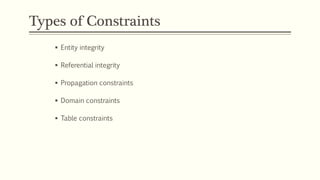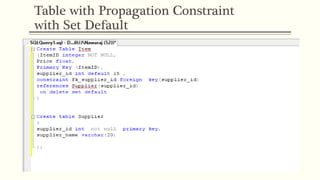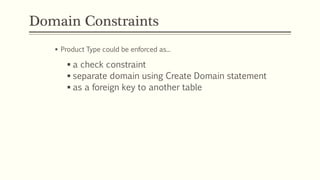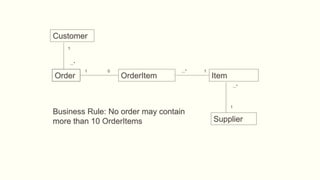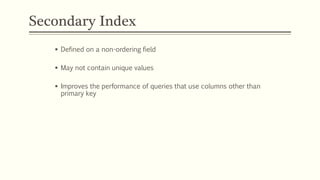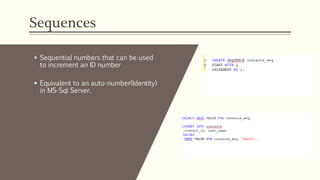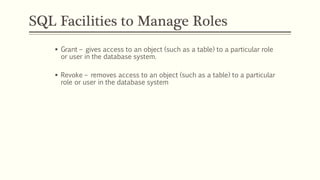Physical Design and Development
- 1. Er. Nawaraj Bhandari Database Design & Developmentf Topic 7 & 8: Physical Design 2
- 2. Types of Constraints Entity integrity Referential integrity Propagation constraints Domain constraints Table constraints
- 3. Activity – Recap - 1 What is the Entity integrity rule? What is referential integrity?
- 4. Activity – Recap - 2 What is the Entity integrity rule? The primary key of an entity cannot contain nulls. What is referential integrity? If a foreign key contains a value then that value must refer to an existing tuple in the source table
- 5. The Art Suppliers data model - where will there need to be constraints? Order OrderItem Item Supplier 1 1 1 0...* 0...* 0...* Customer 1 0...*
- 6. Source or Parent Table Create table customers (CustomerNo integer(5) not null, first_name varchar(30), last_name varchar(30), primary key emp_no);
- 7. Referencing or Child Table Create table Orders (OrderID integer(5) not null, CustomerID integer(5) not null, OrderDate datetime, primary key OrderID, foreign key (CustomerID) references Customer (CustomerID);
- 8. Referential Integrity Constraint – Another Example Create table workers (emp_no integer(5) not null, first_name varchar(30), last_name varchar(30), job_title varchar(30), age integer(3), dept_no integer(5), primary key emp_no, foreign key (dept_no) references Departments (dept_no)o)
- 9. Propagation Constraint What happens if we delete a Item from our Art Supply database? There are lots of OrderItem records that reference it. What happens to them?
- 10. Options for Propagation No action Cascade Set Default Set Null
- 11. Table with Propagation Constraint with no action and cascade Create Table Item (ItemID integer NOT NULL, SupplierID integer NOT NULL, Price float, Primary Key (ItemID), Foreign Key (SupplierID) REFERENCES Supplier(SupplierID) On delete no action On update cascade);
- 12. Table with Propagation Constraint with Set Default
- 13. Table with Propagation Constraint with no action and cascade Create Table Item (ItemID integer NOT NULL, SupplierID integer NOT NULL, Price float, Primary Key (ItemID), Foreign Key (SupplierID) REFERENCES Supplier(SupplierID) On delete set Null On update set Null);
- 14. Domain Constraints Product Type could be enforced as... a check constraint separate domain using Create Domain statement as a foreign key to another table
- 15. Check Constraint Create Table ProductType (ProductTypeID integer NOT NULL, ProductTypeName varchar (30) NOT NULL, ProductTypeColour varchar (20), Primary Key (ProductTypeID) Check (ProductTypeColour in ‘Red’,’Blue’,’Green’));
- 16. As a Separate Domain Create Domain ProductTypeColour As varchar(20) Default ‘Red’ Check (Value in (‘Red’,’Blue’,’Green’)); The table’ProductType’ will set the ProductTypeColour attribute as this domain ProductTypeColour Create Table ProductType (ProductTypeID integer NOT NULL, ProductTypeName varchar (30) NOT NULL, ProductTypeColour BoatType, Primary Key (ProductTypeID));
- 17. As a Separate Table Create Table ProductTypeColour( (ProductTypeColourCode Varchar(3), ProductTypeColourDescription Varchar(20) Primary Key (ProductTypeColourCode)); With the corresponding Foreign Key in Boat Create Table ProductType (ProductTypeID integer NOT NULL, ProductTypeName varchar (30) NOT NULL, ProductTypeColour varchar (3), Primary Key (ProductTypeID) Foreign Key (ProductTypeColourCode) References ProductTypeColour (ProductTypeColourCode));
- 18. Business Rules Enforced by Constraints Business rules are derived from requirements analysis and documented in logical design They depend on the operations of the ‘real world’ business
- 19. Business Rule: No order may contain more than 10 OrderItems Order OrderItem Item Supplier 1 1 1 0...* 0...10 0...* Customer 1 0...*
- 20. Table Constraints Create Table Orders ( (OrderID integer NOT NULL, CustomerID integer NOT NULL, OrderDate datetime NOT NULL Constraint MaximumOrderItems Check(Not Exists(Select OrderID From OrderItems Group By OrderID Having Count(*) >10)), Primary Key (OrderID) Foreign Key (CustomerID) REFERENCES Customer(CustomerID) On delete no action On update cascade);
- 21. Table Constraints – Another Example Create Table Rental ( (BoatID integer NOT NULL, CustomerID integer NOT NULL, RentalStartDate datetime NOT NULL, RentalEndDate datetime NOT NULL Constraint MaximumRentals Check(Not Exists(Select BoatID From Rentals Group By BoatID Having Count(*) >10)), Primary Key (BoatID, CustomerID, RentalStartDate) Foreign Key (CustomerID) REFERENCES Customer(CustomerID), Foreign Key (BoatID) REFERENCES Boat (BoatID) On delete no action On update cascade);
- 22. Some Additional Database Structures Views Indexes Sequences
- 23. View of selected rows or columns of these tables Improving Performance with the use of Views Table 1 Table 2 Table 3 Query
- 24. Example of Creating a View Create View OrderSummary as (Select O.OrderID, O.OrderDate, I.ItemName, I.Price, OI.Quantity, O.Total From Orders O, OrderItems OI, Items I Where O.OrderID = OrderItems.OrderID And I.ItemID = OI.ItemID); What will be the purpose of this view?
- 25. Indexes Improve performance. They work by creating entries in a special structure that makes it easier to find a record
- 26. Index Types Primary index Secondary index Clustering index
- 27. Primary Index Built around a key field that is used for ordering. A unique value for every entry in the index.
- 28. Secondary Index Defined on a non-ordering field May not contain unique values Improves the performance of queries that use columns other than primary key
- 29. Use of Secondary Indexes Mechanism for specifying additional key columns. For example Customer would be searched often on Customer Name as well as the primary key and so a secondary index could be used on it.
- 30. Examples of Creating Indexes in SQL To create primary index CREATE UNIQUE INDEX CustomerIDIndex ON Customer(CustomerID) To create clustering index CREATE INDEX OrderDateIndex ON Order(OrderDate) CLUSTER( for Oracle) To create secondary index use CREATE INDEX syntax without specifying unique.
- 31. Clustered Indexes A clustered index alters the way that the rows are physically stored. When you create a clustered index on a column the database server sorts the table’s rows by that column(s). It is like a dictionary, where all words are sorted in an alphabetical order. (**) Note, that only one clustered index can be created per table i.e. Primarary Key. It alters the way the table is physically stored, it couldn’t be otherwise.
- 32. Non-Clustered Indexes It creates a completely different object within the table, that contains the column(s) selected for indexing and a pointer back to the table’s rows containing the data. It is like an index in the last pages of a book. All keywords are sorted and contain a reference back to the appropriate page number. A non- clustered index on the computer_id column, in the previous example, would look like the table below:
- 33. Clustered Vs Non-Clustered Indexes
- 34. Overheads of Use of Indexes A record is added to the index table every time a new record is added to the table where there is a secondary index. Updating the indexed record means an update to the index table More disk space need to store index tables Impact on performance if indexes are all consulted every time a query is run
- 35. Sequences Sequential numbers that can be used to increment an ID number Equivalent to an auto-number(Identity) in MS-Sql Server.
- 36. De-normalisation We have created a database following all the rules of normalisation... Now we can break them to make the database work quicker and perform better...
- 37. Roles in a System Not every user is the same The will need to access different parts of the system and access it in different ways
- 38. SQL Facilities to Manage Roles Grant – gives access to an object (such as a table) to a particular role or user in the database system. Revoke – removes access to an object (such as a table) to a particular role or user in the database system
- 39. Grant Grant create on Customers to Admin Grant all on Customers to Manager
- 40. Revoke Revoke all on Customers from Admin Revoke delete on Customers to Manager
- 41. ANY QUESTIONS?
- 42. Past Questions Revision Why does physical design require an understanding of the chosen DBMS product? In physical design the database is designed with the target Database Management System (DBMS) in mind. Therefore it entails knowledge of the chosen DBMS whether it is Oracle, MySQL, SQL Server etc. The particular features of the chosen system might specify how structures are set up and stored physically new features get added and older features become obsolete.
- 43. Past Questions Revision Define the types of information that should be recorded for each table and column at the physical design stage. For each table: • Table name • List of columns • Primary key and foreign keys. Any alternate keys • Referential integrity constraints for each of the foreign keys that have been identified For each column: • The domain of that column including the data-type, length and any additional constraints that apply to that column • A default value for the column • Whether the column is derived and if it is derived then how it is computed • Whether or not the column can contain null values
- 44. Past Questions Revision Explain the concept of derived data.: Derived data is defined as a column whose value is derived from the value of one or more other columns in the database. These might be columns within the same table or columns from one or more other tables.
- 45. Past Questions Revision How can an organization's derived data make the process of normalization and data design. In an organization there is usually a lot of derived data such as totals for the number of products ordered. When looking at documents during normalization we sometimes come across derived data so we must make sure that we map its derivation rather than simply duplicating it.. With regard to design there are similar problems to those in normalization. Also the derived columns will need to be modeled. Decisions as to how they are modeled need to take into account aspects like performance.
- 46. Past Questions Revision What role can SQL views play with regard to derived data? Views are ways of storing queries across tables They can be used to store the results of calculations such as those used with aggregate functions.
- 47. Past Questions Revision Explain with an example the function of database triggers Database triggers are pieces of procedural logic that are attached to database objects that operate (‘fire’) upon some event happening such as a new row being inserted into the database.
- 48. Past Questions Revision Discuss the ways in which a business rule can be enforced in a database management system. Built into the structure of the database through the normal constraints e.g. a business rule like ‘Every person must have an address’ would mean that address fields are specified as not null. A rule like ‘A student must be enrolled on a course’ would be a non-null referential integrity constraint (foreign key). More complex business rules can be enforced with check constraints. Applications can also be used to enforce business rules through the logic of whatever programming language they are built in. Database triggers can also be used to enforce business rules.
- 49. Past Questions Revision Explain what an index is in a database system. Indexes in databases operate in much the same way as an index in a book. They are separate files that contain location pointers to the actual rows in the database. Instead of a topic title like in a book index they usually contain one or more attributes that belong to a row. They could, for example, contain just customer numbers from a customer table, rather than all the data for the customers as the actual database contains.
- 50. Past Questions Revision Identify and describe THREE (3) different types of index. The different types of indexes available are primary index, secondary index and clustering index. A primary index is built around a key field with a unique value for every entry. A secondary index is used for specifying additional key columns. A clustering index is built around a field which can have many corresponding rows in the table.
- 51. Past Questions Revision What is a sequence in a database system and what is it used for? A sequence is a structure that generates a number one after the other. It is used to populate fields such serial numbers
- 52. Past Questions Revision Outline the process of enforcing referential integrity in a database system. Foreign keys are identified during the design stage of development when relationships on an ER diagram are mapped between foreign keys and their referenced parent key It is enforced by the use of constraints known as referential integrity constraints that are created either when the table is created or later using he alter table command
- 53. Past Questions Revision With the use of an example define and explain the purpose of de-normalisation De-normalisation is another way of improving performance De-normalisation involves using replication in a controlled way. Attributes that do not belong to a particular table but are often retrieved with that table in queries are replicated on that that table.
Editor's Notes
- clustered index determines the physical order of the rows in the database
- clustered index determines the physical order of the rows in the database
- clustered index determines the physical order of the rows in the database

